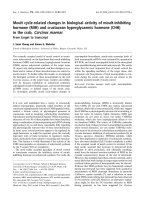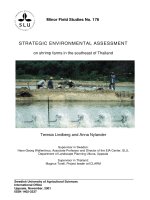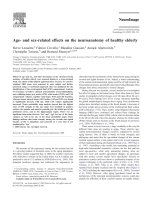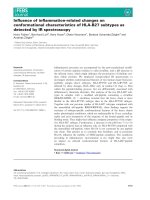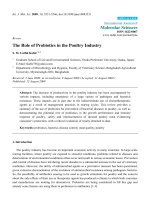Age related changes in the histoarchitecture of seminiferous epithelium in mice
Bạn đang xem bản rút gọn của tài liệu. Xem và tải ngay bản đầy đủ của tài liệu tại đây (522.57 KB, 7 trang )
Int.J.Curr.Microbiol.App.Sci (2017) 6(5): 2509-2515
International Journal of Current Microbiology and Applied Sciences
ISSN: 2319-7706 Volume 6 Number 5 (2017) pp. 2509-2515
89
Journal homepage:
Original Research Article
/>
Age Related Changes in the Histoarchitecture of
Seminiferous Epithelium in Mice
R. Kaavya1, T.A.Kannan2*, Sabiha Hayath Basha, S.Vairamuthu3,
Geetha Ramesh1 and B. Justin William2
1
Department of Veterinary Anatomy, Madras Veterinary College, Tamil Nadu Veterinary and
Animal Sciences University, Chennai- 600 007, India
2
Centre for Stem Cell Research and Regenerative Medicine, Madras Veterinary College, Tamil
Nadu Veterinary and Animal Sciences University, Chennai- 600 007, India
3
Central Clinical Laboratory, Madras Veterinary College, Tamil Nadu Veterinary and Animal
Sciences University, Chennai- 600 007, India
*Corresponding author
ABSTRACT
Keywords
Seminiferous
epithelium,
Histoarchitecture,
Age related
changes,
Mice
Article Info
Accepted:
25 April 2017
Available Online:
10 May 2017
In the present study, the histoarchitecture of seminiferous epithelium of
testis in pre-pubertal and post-pubertal mice were observed. Mice
belonging to the age three days post-partum to eight weeks were used. The
histological observation of the testes up to six days post- partum in the
present study showed that the semeniferous epithelium was made up of two
distinct cell types’ viz., gonocytes and sertoli cells. At day eight
postpartum, both Type A and Type B spermatogonia were observed on the
basement membrane of seminiferous tubules. After ten days post-partum,
primary spermatocytes were observed in two to four layers next to
spermatogonial layer. Both the age groups showed the presence of Leydig
cells and Sertoli cells. In addition to these cellular populations, testes of
post-pubertal age groups showed secondary spermatocytes, round and
elongated spermatids.
Introduction
Testis is the primary organ of male
reproductive system and is a bipartite
glandular organ, with both exocrine and
endocrine components (Siu and Cheng, 2004
and Moustafa et al., 2015). To carry out these
dual roles, testicular parenchyma is composed
of two compartments, a seminiferous tubular
compartment and an interstitial compartment.
The tubular compartment consists of an outer
layer of peritubular connective tissue and an
inner layer of seminiferous epithelium resting
upon acellular basement membrane. The
seminiferous epithelium consists of two types
of cells, germ cells and sertoli cells
(Ravindranath et al., 2003).
The histomorphological features of the testis,
at various stages of growth and development,
2509
Int.J.Curr.Microbiol.App.Sci (2017) 6(5): 2509-2515
have been described in several domestic
animal and avian species (Carmon and Green,
1952; Orsi et al., 1987; Sanchez et al., 1993;
Wrobel, 2000; França and Godinho, 2003;
Zayed and Moustafa, 1996; Kannan et al.,
2015), whereas, the present study emphasised
on the histomorphological changes in
cellularity of seminiferous epithelium of
mice.
Spermatogenesis is a continuous process in
adult life due to the presence of unipotent
adult
stem
cells,
defined
as
the
spermatogonial stem cells (SSCs) located
along the basement membrane of the
seminiferous tubules. SSCs were derived
from gonocytes, which in turn, arose from
primordial germ cells (PGCs). During
embryogenesis, PGCs migrated from the yolk
sac to the genital ridge. The arrival of PGCs
stimulated the formation of the primitive sex
cords. Once the seminiferous cords were fully
formed, the PGCs were considered gonocytes
(Senger, 2005). The first biologically active
SSCs appeared 3 to 4 days postpartum in the
male mouse (McLean et al., 2003).
Spermatogenesis occurs in 35 days in mice
(Treuting and Dintzis, 2012), 5-7 days after
birth in rodents and 10-13 years after birth in
humans (Dym et al., 2009).
Chennai-600 051. At the time of collection,
the animals were apparently healthy and
maintained in controlled environment.
Animals were euthanized by using chloroform
instead of CO2 asphyxiation and testes were
removed as per Geetha Ramesh et al., (2016).
Tissue pieces were collected from testes of
pre-pubertal and post-pubertal age groups and
were rinsed in normal saline and fixed in 10
per cent neutral buffered formalin and
Bouin’s fluid. The fixed tissues were
dehydrated in ascending grades of alcohol,
cleared in xylene and embedded in paraffin
wax (Kannan et al., 2015). Tissue sections
were cut at 3-5 micron thickness in rotary
microtome and used for the routine
Haematoxylin-eosin
staining
method
(Bancroft and Stevens, 2014).
Results and Discussion
In the present study, in both pre-pubertal and
post-pubertal age groups, the parenchyma of
the testes was composed of numerous densely
packed semeniferous tubules with interstitial
cells in between (Fig.1) which is in
accordance with the findings of Treuting and
Dintzis (2012).
Pre-Pubertal
The knowledge about histoarchitecture of
seminiferous
epithelium
helps
in
understanding the spermatogenesis in mice.
Hence, the present study was carried out in
age relate changes in seminiferous epithelium
of pre-pubertal and post-pubertal mice.
Materials and Methods
Testis samples were collected from eight prepubertal (0-4 weeks) and eight post-pubertal
(4-8 weeks) mice. The mice were purchased
from the Laboratory Animal Medicine unit,
Madhavaram Milk Colony, Tamil Nadu
Veterinary and Animal Sciences University,
In the pre-pubertal mice, the seminiferous
epithelium was composed of gonocytes,
spermatogonia, primary spermatocytes and
sertoli cells. The histological observation of
the testes up to six days of post partum in the
present study showed that the semeniferous
epithelium was made up of two distinct cell
types viz., gonocytes and sertoli cells. The
gonocytes were evident as large, round cells
in the centre of the tubule. The cytoplasm
contained a spherical nucleus dispersed with
homogenous chromatin and prominent
nucleolus (Fig. 2). These findings are in
accordance with Bellve et al., (1977) in pre-
2510
Int.J.Curr.Microbiol.App.Sci (2017) 6(5): 2509-2515
pubertal mice and McLean et al., (2003) in
neonatal mice.
smaller than Type A and showed an increased
amount of heterochromatin (Fig.3).
The distribution of gonocytes at the centre of
the tubule indicated that the mitosis has not
been initiated in gonocytes until birth (Orth et
al., 2000; McLean et al., 2003).
At day ten post-partum, the seminiferous
tubules of the testes contained primary
spermatocytes. Spermatogonial cells formed a
single layer and were observed to rest upon
the basement membrane. Two types of
spermatogonia were identified based on the
appearance of the nuclear chromatin. Type A
spermatogonia was pale and showed oval,
intensely basophilic nucleus. Type B
spermatogonia were darker and showed oval
nucleus with condensed clumps of chromatin
(Fig.4).
At day six post-partum, the gonocytes had
migrated from the centre to the basement
membrane of the seminiferous tubule and
differentiated to form primitive type A
spermatogonia. No gonocytes were visible in
the centre of the tubule after day six postpartum (McLean et al., 2003). This indicated
the onset of first wave of spermatogenesis in
mice.
At day eight post-partum, two types of
spermatogonia viz., Type A and Type B
spermatogonia were observed resting upon
the
basement
membrane.
Type
A
spermatogonia were pale, had a reduced
nuclear and cytoplasmic ratio. Nuclear
chromatin was homogenous with a nucleoli.
Type B spermatogonia were darker and
Above the spermatogonial cell layer, two to
four layers of primary spermatocytes at
various stages of mitotic division were
observed. The primary spermatocytes were
larger than the spermatogonial cell. The
nucleus was round, centrally placed and
basophilic in nature. It showed active
chromatin.
Figure.1 Photomicrograph showing cross section of testis from pre-pubertal mouse
H&E X 100
C- Capsule St- Seminiferous tubules
2511
Int.J.Curr.Microbiol.App.Sci (2017) 6(5): 2509-2515
Figure.2 Photomicrograph of testis of a three day-old mice showing the cross section of
seminiferous tubules with Gonocytes
H&E x 200
G- Gonocytes
Figure.3 Photomicrograph of testis of a ten day-old mice showing the
Cellular components of seminiferous epithelium
H&E X 400
A-Type A spermatogonia,
B- Type B Spermatogonia,
L- Leydig Cell,
Ps- Primary spermatocytes
2512
Int.J.Curr.Microbiol.App.Sci (2017) 6(5): 2509-2515
Figure.4 Photomicrograph of testis of a ten day-old mice showing the cellular
Components of seminiferous epithelium
H&E x 1000
Ad- Type-A dark spermatogonia, Ap- Type A pale spermatogonia,
B- Type B spermatogonia,
PS-Primary Spermatocyte, Sc- Sertoli cell
Figure.5 Photomicrograph of testis of post-pubertal mice showing the cellular
Components of seminiferous epithelium
H&E x 400
A-Type a Spermatogonia, B- Type B spermatogonia, Sc- Sertoli cell,
Ps- Primary Spermatocyte, Ss- Secondary spermatocytes,
R- Round Spermatid, E- Elongated spermatid
2513
Int.J.Curr.Microbiol.App.Sci (2017) 6(5): 2509-2515
There were no secondary spermatocytes and
spermatids observed in pre-pubertal mice.
This is in contrast to the findings of Singh et
al., (2015) in Wistar Rats who observed
actively
dividing
spermatogonia,
spermatocytes, round spermatids, Leydig cells
and Sertoli cells from pre-pubertal age
groups.
Post-Pubertal
In post-pubertal mice, the seminiferous
epithelium was composed of spermatogonial
cells, primary and secondary spermatocytes
and spermatids. The supporting or sertoli cells
were situated in between them as per de Rooij
and Grootegoed (1998). Based on the
appearance of nuclear chromatin, three types
of spermatogonia were identified in the
present study. Type a dark (Ad)
spermatogonia showed oval, intensely
basophilic nucleus. Type A pale (Ap)
spermatogonia showed lightly stained oval
nucleus whereas Type B spermatogonia
showed oval nucleus with condensed clumps
of chromatin (Figure 5).
The primary spermatocytes were larger than
spermatogonial cells. It had a large nucleus
with active chromatin which indicated the
mitotic division. Singh et al., (2015) observed
that the primary spermatocyte undergo first
meiotic division to form the spermatids. The
spermatids undergo a series of morphological
and
structural
changes
to
become
spermatozoa, such as formation of acrosome
and tail, chromosome condensation and the
removal of excessive cytoplasm at the time of
spermiation.
In the present study, a concomitant increase in
number of Type A and Type B
spermatogonia, spermatocytes, spermatids,
sertoli and leydig cells were observed in postpubertal mice when compared to pre-pubertal
age group. A similar observation has been
made by Singh et al., (2015) in post-pubertal
Wistar rats.
The secondary spermatocytes were smaller
than primary spermatocytes and the nucleus
contained euchromatin. Above this layer,
secondary spermatocytes, numerous round
and elongated spermatids were observed in
the adluminal region. The sertoli cells were
larger and the nuclear cytoplasmic ratio was
observed more. The nucleus was oval, located
in the broader portion of the cell with small
nucleoli. Numerous spermatids were seen
attached to the sertoli cells (Figure 5). This
finding is in accordance with the observations
of Eurell and Frappier (2006) in mammalian
testes.
Acknowledgements
Authors are highly thankful to the Centre for
Stem Cell Research and Regenerative Medicine,
Madras Veterinary College, Chennai – 600 007
for providing necessary facilities to carry out
the study. The authors also acknowledges the
Dean, Madras Veterinary College, Chennai –
600 007 for providing necessary Financial
support.
References
Bancroft, J.D. and A. Stevens. 2014. Theory
and practice of Histological techniques,
13th Ed., Churchill Livingstone, London.
Bellve, A.R., J.C. Cavicchi, C.F. Milletfe, D.A.
O'brien, Y.M. Bhatnagar and M. Dym.
1977. Spermatogenic cells of the
prepuberal
mouse
Isolation
and
Morphological Characterization. J. Cell.
Biol., 74: 68-85.
Brinster, R.L. 2002. Germline stem cell
transplantation and transgenesis. Sci., 296:
2174–76.
Brinster, R.L. 2007. Male Germline Stem Cells:
From Mice to Men. Sci., 316: 404–405.
Carmon, J.L. and W.W. Green. 1952.
Histological study of the development of
the testis of the ram. J. Anim Sci., 674-687.
2514
Int.J.Curr.Microbiol.App.Sci (2017) 6(5): 2509-2515
de Rooij, D.G. and J.A. Grootegoed, 1998.
Spermatogonial stem cells. Cell Bio., 10:
694-701.
Dym, M., M. Kokkinaki and Z. He. 2009.
Spermatogonial stem cells: mouse and
human comparisons. Birth Defects Res.,
Part C, Embryo Today, 87: 27-34.
França, L.R. and Godinho, C.L. 2003. Testis
morphometry, seminiferous epithelium
cycle length, and daily sperm production in
domestic cats (Felis catus). Biol Reprod.,
68: 1554-1561.
Geetha Ramesh, T.A., Kannan, and M.
Sivakumar.
2016.
Age
related
histochemical changes in Thymus, Spleen
and Mesenteric lymph nodes in Mice, Rat
and Guinea pig. Int. J. Sci. Res., 5(9):
1088-1091.
Kannan, T.A., Geetha Ramesh and M.
Sivakumar. 2015. Age Related Changes in
the gross and histoarchitecture of Testis in
Japanese Quails (Coturnix coturnix
japonica). Int. J. Liv. Res., 5(6): 26-33.
McLaren, A. 1991. Development of the
mammalian gonad: the fate of supporting
cell lineage. BioEssays, 3: 151-156.
McLean, D.J., P.J. Friel, D.S. Johnston and
M.D. Griswold. 2003. Characterization of
spermatogonial stem cell maturation and
differentiation in neonatal mice. Biol.
Reprod., 69: 2085-2091.
Moustafa, M.N.K, R.Sayed, A.E.Zayed and
Abd El –Hafeez. 2015. Morphological and
Morphometric Study of the Development
of Seminiferous Epithelium of Donkey
(Equus asinus) from Birth to Maturity. J.
Cytol. Histol., 6(6): 1-8.
Orsi, AM., S.M. Dias, J.E. Moreira and J.A.
Camilli. 1987. Morphological development
of the seminiferous epithelium of the pig at
different ages (Sus scrofa of the Landrace
strain). Anat. Histol. Embryol., 16: 97-102.
Orth, J.M., W.F. Jester, L.H. Li and A.L.
Laslett. 2000. Gonocyte-Sertoli cell
interactions during development of the
neonatal rodent testis. Curr. Top. Dev.
Biol,. 50: 103–124.
Ravindranath, N., L. Dettin and Martin Dym.
2003. Chapter on Mammalian Testis:
Structure and Function. pp 1-19. In
textbook on "Introduction to Mammalian
Reproduction". Springer Publishers, New
York, USA.
Sánchez, B., M. Pizarro, P. García and J.M.
Flores. 1993. Postnatal development of
seminiferous tubules in the cat. J. Reprod.
Fertil. Suppl., 47: 343-348.
Senger, P.L. 2005. Pathways to Pregnancy and
Parturition, Second Revised Edition.
Singh, M.K., N. Nair and R.S. Bedwal. 2015.
Prepubertal to postpubertal development of
testes in Wistar rats: a histological and
morphometric study. The Egyptian J. Hist.,
38(1): 116-125.
Siu, M.K. and C.Y. Cheng. 2004. Dynamic
cross-talk between cells and the
extracellular matrix in the testis. Bioessays,
26: 978-992.
Treuting, P.M. and S.M. Dintzis. 2012.
Comparative Anatomy and Histology: A
mouse and Human Atlas. p: 285-289.
Wrobel, K.H. 2000. Prespermatogenesis and
spermatogoniogenesis in the bovine testis.
Anat. Embryol. (Berl)., 202: 209-222.
Zayed, A.E and M.N.K. Moustafa. 1996. A
histomorphological study on the testis of
dog during postnatal life. Assiut. Vet. Med.
J., 20: 31-46.
How to cite this article:
Kaavya, R., T.A. Kannan, Sabiha Hayath Basha, S. Vairamuthu, Geetha Ramesh and Justin
William, B. 2017. Age Related Changes in the Histoarchitecture of Seminiferous Epithelium in
Mice. Int.J.Curr.Microbiol.App.Sci. 6(5): 2509-2515.
doi: />
2515


